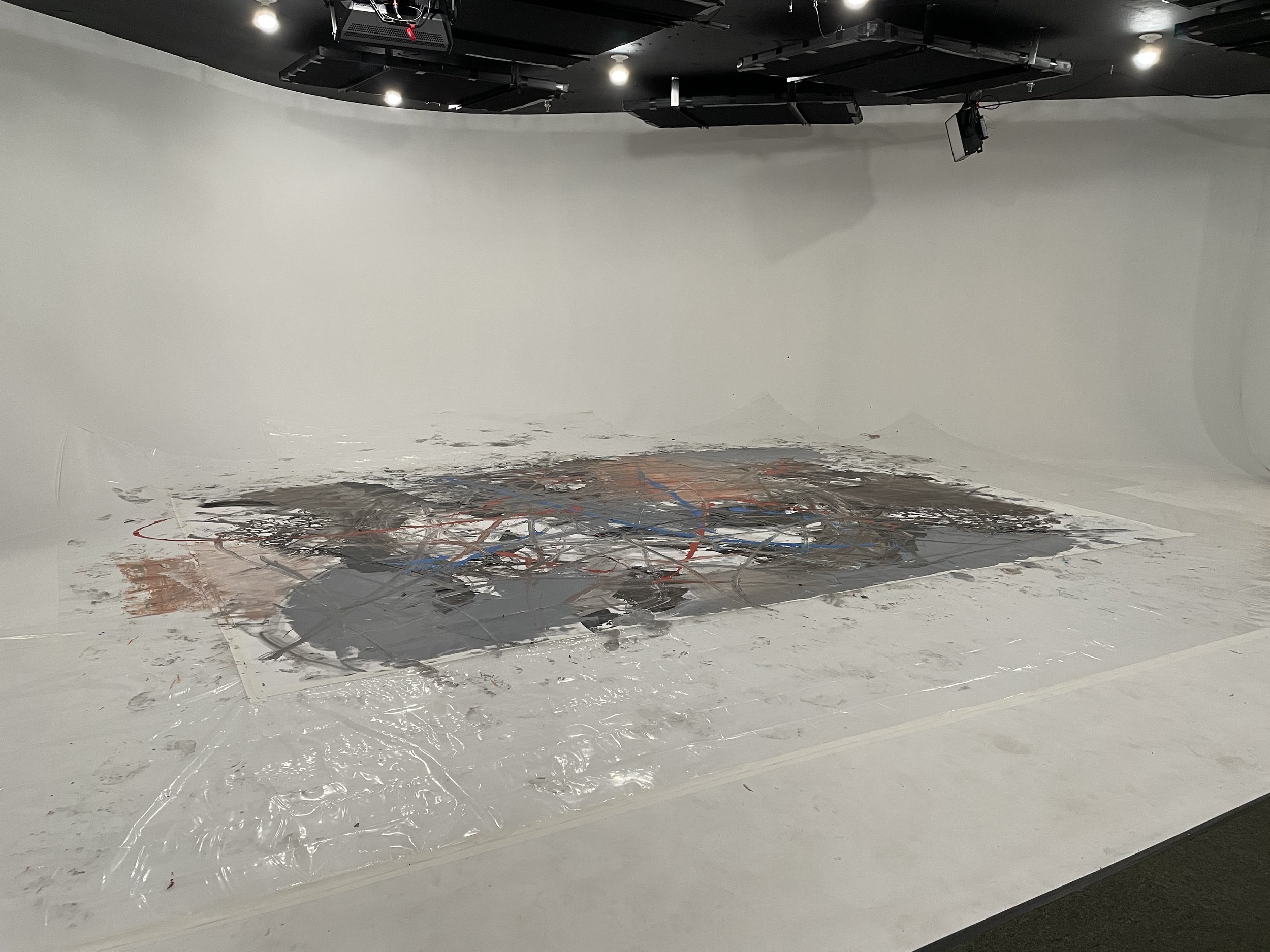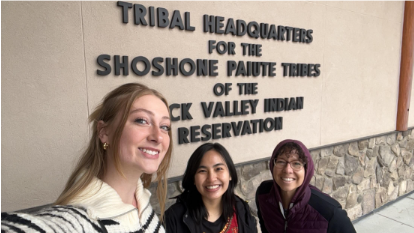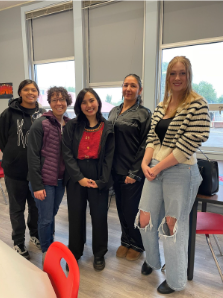Communication & Community
Aloha e komo mai (hello and welcome). OMG Studios Boise got a fresh coat of paint! It has been needed for a while and what a perfect way to transition from old paint to new paint after our All Hallows’ Eve Mixed Media Mixer where artist Luma Jasim performed live. She painted a beautiful masterpiece in our studio while providing us with spoken word about her journey and her life as an artist from Iraq. She was accompanied with soul-touching music by musician Ryan Garrett. Along with Luma, we had artists Britney Brougham, Aryssa Hutchins, Reham Aarti, GiGi Huntley, Free Spirits Beverages, and improv troupe Creatively. It was a wonderful evening of art, conversation, and connection.
Our next mixer takes place on New Years Eve as our 2nd annual New Years Eve Mixed Media Mixer! Can you believe that OMG Studios Boise has been a thing for a year?! I certainly can’t. We will be celebrating our one year anniversary in this space on December 1st. Along with that, this past November 9th, we celebrated #OMGFemaleFilmmakers 6th anniversary as an official LLC! Fall seems to be the time when I decide to create businesses. But don’t worry, that’s not happening this fall. All I’ll be doing is graduating from Southern New Hampshire University with a Master of Art in Communication with an emphasis on New Media and Marketing. And my goodness, that end date cannot come fast enough.
Finding inspiration becomes difficult when your life is filled with client work and grad papers. Grad papers and more grad papers all full of research. It has been 30 months of writing papers, but most importantly, 30 months of learning how to best communicate with, and for, people and businesses. How to listen, work through conflict, and produce communication content that is essential to every business and their internal and external stakeholders.
I have to admit, these skills would have been exceptionally handy in my last relationship; we’d probably at least still be friends. But alas. I am really good at communicating with and for my clients, but still need to work on my personal relationships. And don’t tell me that’s not true for the majority of us.
As we prepare for shorter days, I encourage everyone to take the longer evenings to examine your own communication skills and relationships. What is working? And what is not? How do you share your stories? How do you connect? Rollo May, American psychologist said: Communication leads to community, that is, to understanding, intimacy and mutual valuing.
What do you value and who do you share those values with?
For me, it’s nonprofits whose missions align with my personal and professional values. This past week, we had a three-day shoot with United Vision Idaho who believes that everyone has a place and that “democracy is a fundamental belief system that requires everyone’s daily practice” (UVI, n.d.). They are a “multi-issue, progressive network committed to advancing [their] shared priorities to create real improvements in people’s lives” (UVI, n.d.). During this two day rural democracy summit, plus a third day exploring rural Idaho, we listened to speakers from around the US who are working everyday to “build resilient communities and create a just democracy that works for all of us” (UVI, n.d.). We had conversations. We connected. We asked the questions.
Communication.
As long as we continue to communicate with each other, in whatever capacity, our lives will be richer through that communication and connection.
Note from Steph: November is Native American Heritage Month, a month to honor, recognize, and celebrate the traditions, languages, and stories of Native American, Alaska Native, Native Hawaiian, and affiliated Island communities people. In honor of this month, Aella wrote an article about Native culture, both in the Philippines, and in the US.
The Swaying Banana Leaves
By Rafaella Potestades
In Filipino culture, banana leaves are usually part of our festive and celebratory meals. We use them to wrap our rice and food, we use them to cover our kitchenware, and one of my important functions, we use them as one giant plate where a group of 10 or more people can all eat together. Traditional meals such as Adobo or Bicol express, mounds and mounds of steaming white rice, and grilled tiny squids and salty red crabs are usually strewn across the large green banana leaf. Once the feast starts, so would the stories, the laughter, and the warmth. The banana leaf then becomes a bearer of memories and culture, and a symbol of the Filipino collective spirit and community-based practices.
Culture has always been a tricky discussion because it is shaped by so many people and institutions from diverse ways of living. Yet, at the center of local and indigenous culture is their value system and the people that define it. Similar to how a tree is, local communities in the country are deeply rooted in their values of bayanihan (communal unity and cooperation), pagkakaisa (solidarity), pagaaruga (care), pakikiramay (empathy), and among many others. These values and the people perpetuating them are what defines culture.
While walking around one of the expansive stores in Harvard University, I spotted a book entitled, “Fresh banana leaves: Healing indigenous landscapes through indigenous science” by Jessica Hernandez, PhD. Pausing to read its synopsis, I was enthralled and immediately grabbed it with my cold shaky hands, no doubt because of the biting autumn breeze in Massachusetts. Holding it near to my heart, my hands felt a bit warmer. When I see banana leaves, I always think of home – the land of the banana ketchup, puso ng saging (heart of the banana tree), and banana leaf plates. Seeing the title and reading some of its content made me reflect on the similarities and differences between the situation of indigenous people in the Philippines and in the United States.
One thought came to mind as I flipped through the pages: indigenous values and knowledge systems. Before coming to the United States and joining the YSEALI program, BAYI, Inc, my organization, partnered with Sulong Peace, Inc. to co-manage and implement a feminist leadership program with 16 indigenous women leaders across the Philippines. Through this program, I realized how indigenous knowledge has always been undermined, undervalued, and invisibilized. Even in feminist discussions in the Philippines, so much knowledge goes under our noses and there is so so much to unlearn. During sessions, debates would arise and good practices would be discussed. Everyone was learning something each session. So, once I came to the US, I asked my host supervisor, Steph, the Founder of OMGFemaleFilmmakers and OMG Studios Boise, to hook me up with learning opportunities on American history and cultural studies through the lens of native Americans.
(from left to right is Tessa, Aella, and Steph)
So when I visited Duck Valley, a reservation nestled between Idaho and Nevada, one of the discussions that I had with the Vice Principal of Owyhee Combined School, Lynn John, was on the importance of highlighting indigenous knowledge systems and practices of the Shoshone and Paiute communities as alternative educational solutions in Owyhee. For hundreds of years, indigenous people survived and thrived in their ancestral lands through the value of reciprocity with and respect of nature. Their worldview and practices can provide more sustainable solutions to complex problems in health, security, environmental conservation, natural resource management, politics, and so on. Yet, the capitalist and industrialist system merely disregards this knowledge, or worse, exploits it.
Indigenous knowledge holds so much power, and this was showcased in our visit to the Salish Kootenai College in Pablo, Montana. Tim Ryan from the Culture and Language Studies Department talked about the history and culture of the Salish and Kootenai communities in Montana. One portion that caught my interest was the discussion on fire science and how harnessing the power of fire in a certain way can help forests become healthier. Tim shared how indigenous practices of lighting fires within forests were previously banned by the US government due to it “causing” forest wildfires, without really understanding its role in natural resource management. However, in recent times, government agencies have recognized the value of this indigenous practice as it helps the forest release gases and eradicate invasive plants.
Linda Ferris, one of the language studies teachers in SKC, expressed with passion and heart that language is a reservoir and stream of culture. Words hold history, images, experiences, and realities inside of them so they work hard to preserve and promote the native languages of the Salish and Kootenai tribes. Land, nature, herbs, and animals also capture centuries of traditions and culture, such as their Bitter Root and Bisons. She explained that their way of life centered on community-based values such as reciprocity, care, collective decision-making, and so on. She lamented how historically, federal efforts to eradicate their culture left intergenerational trauma on younger generations.
Lynn John from Owyhee Combined School shared the same sentiment as she cried out that the decades-old physical infrastructure of their school holds trauma that their people experienced. The educational system was weaponized to set a “new” cultural standard that basically degraded, dehumanized, and erased their own people, culture, and languages. Even the paintings on the walls–eye-catching symbols colored with red, white, blue, and black–were erased by their very own people in the name of “standardizing” schools. Similar to the Philippines, our educational system has forgotten indigenous cultures–often making it into a list to memorize or an aftermath–and focused on our colonizers’ socio-cultural, political, and economic influences instead.
So as a way to protect their culture, they found it crucial to document it and pass it to the younger Native American generations across different mediums, such as familial and communal traditions, integration in basic education, and courses on Native American cultures. However, both the Shoshone and Paiute tribes from Owyhee and Salish and Kootenai tribes from Pablo highlighted the danger of their indigenous knowledge and resources being exploited. They shared how corporate interests may commodify their culture such as turning their language education into paid online courses or exploiting their medicinal herbs, such as Bitter Root, for mass pharmaceutical production. In the Philippines, indigenous women weavers face the same form of exploitation such as their handwoven textiles being sold by elite fashion designers for little pay or how banana leaves are mass harvested for massages in the country. It appeared that indigenous people were consistently in a limbo: how do they preserve and promote their culture while collaborating with multi stakeholders, and at the same time, ensuring that it is neither exploited nor commodified? This is one question that I have set my mind to reflect on and will be bringing back to the Philippines to discuss it with the indigenous women themselves.
Lastly, one lesson that I’ll be keeping close to my heart is the deep respect for nature as it has welcomed us to its warm embrace, and became a nest for cultures and peoples. I want to end this article with one of the conversations I had with one of the indigenous women leaders I am close with, a great Hanunuo Mangyan woman from Negros Occidental, and she explained that preserving and promoting our culture is very crucial especially for their younger generations. However, balancing interests and values are essential, and it always boiled down to consulting with the tribal members and forming collective decisions in solidarity and towards social transformation.
The Young Southeast Asian Leaders Initiative Professional Fellows Program (YSEALI PFP) is a program of the U.S. Department of State’s Bureau of Educational and Cultural Affairs and is supported in its implementation by American Councils for International Education and the Mansfield Center at the University of Montana. None of these organizations are responsible for the views expressed herein.
It’s time for another Mixer!
Join us for our quarterly Mixed Media Mixer! This time we’re celebrating the New Year in style. Sunday, December 31st, 6-10pm at OMG Studios Boise in Garden City, we’ll be joined by incredible artists and friends. While we’re still in the planning stages, start preparing your outfits for a night of 1970’s murder mystery fun! More details to follow.
Upcoming Events & Classes
OMG Studios Boise Anniversary & Steph’s Graduation Party!
December 9, 11am-4pm
Come dressed in your best 90’s prom attire to commemorate with Steph on completing grad school and the 1 year anniversary of OMG Studios Boise.
On Saturday, December 9th, 11am-4pm, celebrate Steph’s completion of her grad program at Southern New Hampshire University. She’ll be virtually receiving her Master of Art in Communication with an emphasis on New Media and Marketing, while also celebrating one year as OMG Studios Boise. Bring your favorite snacks and drinks to share with everyone along with your own 90’s awesomeness.
Exploring the Magic of SoulCollage®
Saturday, January 13, 2024, 7:00pm-9:00pm
Join SoulCollage® facilitator Nova Calverley-Chase for an evening of reflection, awakening, and discovery. During this workshop, you will:
intuitively create two collaged cards
give voice to your cards through guided journaling
deepen your awareness and understanding of the many aspects that make up you
$20 - RSVP by Venmo @Nova-Calverley-Chase
(be sure to include your email address)
Questions? Call/text 801-574-0777
or email selkie.soul.dreams@gmail.com









